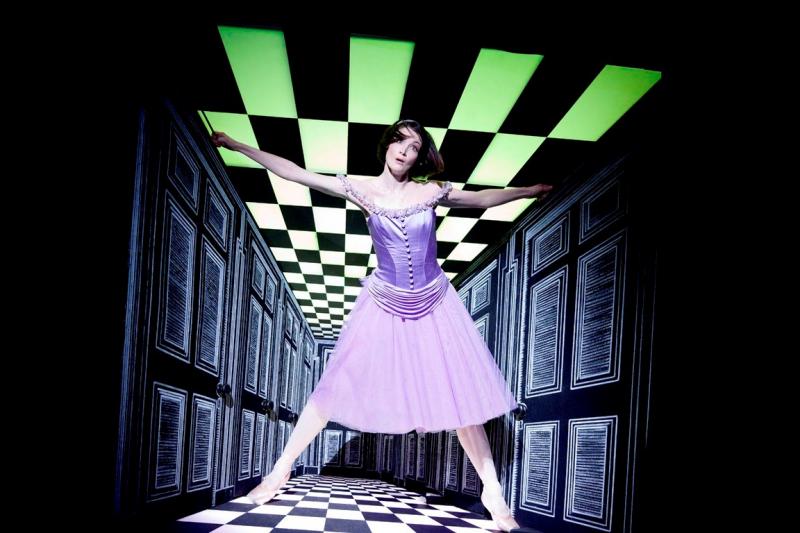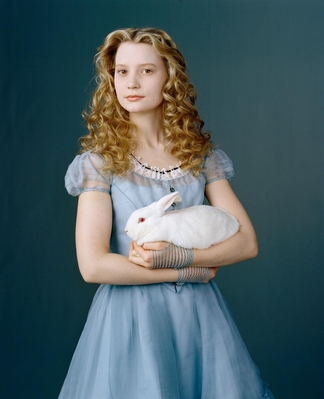Alice's Adventures in Wonderland (2012), Royal Ballet | reviews, news & interviews
Alice's Adventures in Wonderland (2012), Royal Ballet
Alice's Adventures in Wonderland (2012), Royal Ballet
Even the best butter would not help this plot-less evening

"I told you butter wouldn’t suit the works," accuses the Mad Hatter. "It was the best butter," replies the March Hare apologetically, in Lewis Carroll’s original tale. Butter might or might not suit the works onstage in the Royal Ballet’s everything-including-the-kitchen-sink version of Alice in Wonderland. We’ll never know, since Christopher Wheeldon has not used any butter at all, allowing his audience the merest scrape of choreographic margarine.
Early on in Act I, when Alice is with her sisters in the deanery at Christ Church, before she drops down the rabbit-hole, it appears that Wheeldon has been paying attention to what a dance-drama entails: up pop the imperious mother, the hand-shaking older men, the ringleted sisters, and the bobbing, turning, prancing maids of MacMillan’s Mayerling. But immediately after summoning them all, Wheeldon seems to give a shrug, and discards any attempts at story-telling, exchanging that for endless noodling solos for Alice.
 A seasoned dramaturg would have told him his choice of story had doomed him to this, since Alice in Wonderland is not, properly speaking, a novel at all, with rounded characters, or anything as eccentric as a plot. Instead it is a picaresque, with a single character moving from scene to scene, each designed merely to answer the question, And then? And then? So poor, perky Lauren Cuthbertson bourées and arabesques without focus between groups of people who have no interest in her, or in each other, at all.
A seasoned dramaturg would have told him his choice of story had doomed him to this, since Alice in Wonderland is not, properly speaking, a novel at all, with rounded characters, or anything as eccentric as a plot. Instead it is a picaresque, with a single character moving from scene to scene, each designed merely to answer the question, And then? And then? So poor, perky Lauren Cuthbertson bourées and arabesques without focus between groups of people who have no interest in her, or in each other, at all.
There has been some extensive reworking, it is true, since the ballet was premiered last spring. Some of the changes are helpful: there is certainly more actual dance than in the original. (The piece is a co-production with the National Ballet of Canada, and it appears that additional choreography was inserted when the piece was first mounted there.) The evening is now in three, rather than two, acts: originally, the first act lasted a full 70 minutes, whereas now it is a more child-friendly 45.
But these tinkerings come at a price, the extra interval stretching the evening out to nearly three hours. And the new act break is dramatically uncertain, just finishing in mid-air rather than concluding coherently: Alice is in a pas de trois with the White Rabbit and the Jack of Hearts. She is blindfolded and turns, bewildered, as the curtain comes down. As well she might be. There is no explanation of what the blindfold is for, and when we return to the same point at the start of Act II, it is immediately discarded.
Despite the cosmetic surgery, the core of the problem remains: Wheeldon does not appear to know how to use dance to tell a story. Instead, the props, the special effects and the scenery (Bob Crowley's fine work) tell the story, and dancing is what happens in front and in between these moments.
 Joby Talbot’s score is not much help in building a shape for the piece, following rather than impelling the action, and intermittently swelling with lushly emotional strings whenever a bit of oomph is called for – is he, in fact, the Sigmund Romberg of the dance world?
Joby Talbot’s score is not much help in building a shape for the piece, following rather than impelling the action, and intermittently swelling with lushly emotional strings whenever a bit of oomph is called for – is he, in fact, the Sigmund Romberg of the dance world?
It is not unreasonable to hark back to the creator of The Student Prince: a frothy entertainment that pretended to be an opera. Art repays repeated viewings; entertainments give up all they have on a single visit. And reviewing this piece for the second time, I feel like a policeman after an accident: “Move along now, move along, there’s nothing to see here.”
It seems unkind to go on about what a mess this piece is. Everyone concerned really does their utmost to make the work appear coherent – apart from high production values from Crowley and his colleagues, kudos as always to Edward Watson, whose batterie is now really a thing of beauty; to Eric Underwood, who is once more burdened with the “exotic” role (which, by the bye, in 19th-century ballet is almost bearable as a period piece; in a work choreographed in 2011 is an embarrassment) but who performs with dignity nonetheless; to Steven McRae and Ricardo Cervera who team up admirably as the Mad Hatter and the March Hare. But these heroic efforts are rendered null. The piece is slick, smooth, creamy and glossy. It’s also a waste of everyone’s time and talents. Not the best butter at all.
ALICE'S ADVENTURES ON STAGE AND SCREEN
Alice, Scottish Ballet. It should be a capital crime to attempt an Alice ballet - off with their heads
Alice's Adventures Under Ground, Barbican. Gerald Barry's crazy velocity berserks both Alice books in rude style
 Alice in Wonderland. Tim Burton takes on the fantasy classic
Alice in Wonderland. Tim Burton takes on the fantasy classic
Alice in Wonderland, BBCSO, Brönnimann, Barbican. A curious tale gets a riotous operatic telling from composer Unsuk Chin
Alice Through the Looking Glass. Mia Wasikowska (pictured), Helena Bonham Carter and Johnny Depp back in inventive if unfaithful Carroll sequel
Jan Švankmajer's Alice. The great Czech animator's remarkable first full-length film
wonder.land, National Theatre. Damon Albarn’s Alice musical has fun graphics, but a banal and didactic storyline
Share this article
The future of Arts Journalism
You can stop theartsdesk.com closing!
We urgently need financing to survive. Our fundraising drive has thus far raised £49,000 but we need to reach £100,000 or we will be forced to close. Please contribute here: https://gofund.me/c3f6033d
And if you can forward this information to anyone who might assist, we’d be grateful.

Subscribe to theartsdesk.com
Thank you for continuing to read our work on theartsdesk.com. For unlimited access to every article in its entirety, including our archive of more than 15,000 pieces, we're asking for £5 per month or £40 per year. We feel it's a very good deal, and hope you do too.
To take a subscription now simply click here.
And if you're looking for that extra gift for a friend or family member, why not treat them to a theartsdesk.com gift subscription?
more Dance
 'We are bowled over!' Thank you for your messages of love and support
Much-appreciated words of commendation from readers and the cultural community
'We are bowled over!' Thank you for your messages of love and support
Much-appreciated words of commendation from readers and the cultural community
 R:Evolution, English National Ballet, Sadler's Wells review - a vibrant survey of ballet in four acts
ENB set the bar high with this mixed bill, but they meet its challenges thrillingly
R:Evolution, English National Ballet, Sadler's Wells review - a vibrant survey of ballet in four acts
ENB set the bar high with this mixed bill, but they meet its challenges thrillingly
 Like Water for Chocolate, Royal Ballet review - splendid dancing and sets, but there's too much plot
Christopher Wheeldon's version looks great but is too muddling to connect with fully
Like Water for Chocolate, Royal Ballet review - splendid dancing and sets, but there's too much plot
Christopher Wheeldon's version looks great but is too muddling to connect with fully
 iD-Reloaded, Cirque Éloize, Marlowe Theatre, Canterbury review - attitude, energy and invention
A riotous blend of urban dance music, hip hop and contemporary circus
iD-Reloaded, Cirque Éloize, Marlowe Theatre, Canterbury review - attitude, energy and invention
A riotous blend of urban dance music, hip hop and contemporary circus
 How to be a Dancer in 72,000 Easy Lessons, Teaċ Daṁsa review - a riveting account of a life in dance
Michael Keegan-Dolan's unique hybrid of physical theatre and comic monologue
How to be a Dancer in 72,000 Easy Lessons, Teaċ Daṁsa review - a riveting account of a life in dance
Michael Keegan-Dolan's unique hybrid of physical theatre and comic monologue
 A Single Man, Linbury Theatre review - an anatomy of melancholy, with breaks in the clouds
Ed Watson and Jonathan Goddard are extraordinary in Jonathan Watkins' dance theatre adaptation of Isherwood's novel
A Single Man, Linbury Theatre review - an anatomy of melancholy, with breaks in the clouds
Ed Watson and Jonathan Goddard are extraordinary in Jonathan Watkins' dance theatre adaptation of Isherwood's novel
 Peaky Blinders: The Redemption of Thomas Shelby, Rambert, Sadler's Wells review - exciting dancing, if you can see it
Six TV series reduced to 100 minutes' dance time doesn't quite compute
Peaky Blinders: The Redemption of Thomas Shelby, Rambert, Sadler's Wells review - exciting dancing, if you can see it
Six TV series reduced to 100 minutes' dance time doesn't quite compute
 Giselle, National Ballet of Japan review - return of a classic, refreshed and impeccably danced
First visit by Miyako Yoshida's company leaves you wanting more
Giselle, National Ballet of Japan review - return of a classic, refreshed and impeccably danced
First visit by Miyako Yoshida's company leaves you wanting more
 Quadrophenia, Sadler's Wells review - missed opportunity to give new stage life to a Who classic
The brilliant cast need a tighter score and a stronger narrative
Quadrophenia, Sadler's Wells review - missed opportunity to give new stage life to a Who classic
The brilliant cast need a tighter score and a stronger narrative
 The Midnight Bell, Sadler's Wells review - a first reprise for one of Matthew Bourne's most compelling shows to date
The after-hours lives of the sad and lonely are drawn with compassion, originality and skill
The Midnight Bell, Sadler's Wells review - a first reprise for one of Matthew Bourne's most compelling shows to date
The after-hours lives of the sad and lonely are drawn with compassion, originality and skill
 Ballet to Broadway: Wheeldon Works, Royal Ballet review - the impressive range and reach of Christopher Wheeldon's craft
The title says it: as dancemaker, as creative magnet, the man clearly works his socks off
Ballet to Broadway: Wheeldon Works, Royal Ballet review - the impressive range and reach of Christopher Wheeldon's craft
The title says it: as dancemaker, as creative magnet, the man clearly works his socks off
 The Forsythe Programme, English National Ballet review - brains, beauty and bravura
Once again the veteran choreographer and maverick William Forsythe raises ENB's game
The Forsythe Programme, English National Ballet review - brains, beauty and bravura
Once again the veteran choreographer and maverick William Forsythe raises ENB's game

Add comment